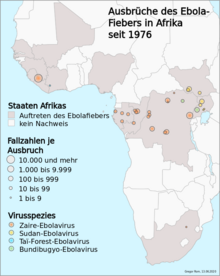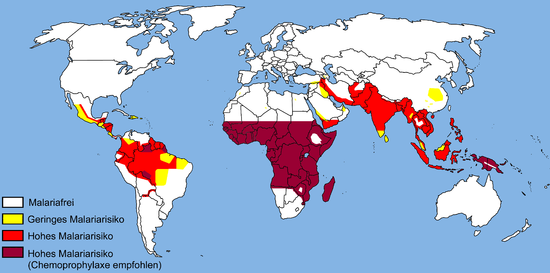Endemic
The term endemic (from ancient Greek ἐν en 'in' and δῆμος dēmos 'people') is used in medicine when cases of a disease continue to accumulate in a circumscribed population or limited region .

In the case of an endemic , viewed over a longer period of time in the affected population or region, both the prevalence (disease frequency ) and the incidence (new disease frequency) of a certain disease are increased compared to other populations or regions and remain at the increased endemic level with slight fluctuations .
This does not necessarily have to be an infectious disease , as the classic example of endemic goiter shows, the frequent occurrence of an enlarged thyroid gland caused by a lack of iodine in food and drinking water, for example in alpine regions. The corresponding geographic region is known as the endemic area. It can also be a natural source of pathogenic factors for humans . Examples of this are enzootic areas of zoonoses , which have their reservoir in animal populations and occasionally cause diseases such as the plague when transmitted to humans . For Ebola fever occurring in Central African regions , the natural reservoir host of the Ebola virus has not yet been identified with certainty; fruit bats are considered likely .
Given the endemic status of an infectious disease in a particular region, the number of cases of the disease in the local population has increased steadily and remains roughly the same. Epidemiologically so the product of basic reproductive rate (is considered so basic reproduction number R 0 ) and Empfänglichkeitsrate ( susceptibility number S ) is equal to one: .
An endemic status indicates a continuously increasing number of cases after it has continued, not according to the level of the disease. If diseases with high contagiousness and high mortality occur, such as Ebola fever, outbreaks occur with a rapidly increasing number of illnesses and later deaths, but not a lasting endemic status. This is not the case with malaria , which is one of the most common infectious diseases in the world and is endemic to various levels in around a hundred countries. The endemic areas in the distribution area of the Anopheles mosquito differ in the risk of becoming one of the 200 million new cases per year through the transmission of the pathogen , a human-pathogenic Plasmodium .

In contrast to this, the only temporary or only recently observed increased occurrence of cases of illness with a clear increase in prevalence and incidence is referred to as an epidemic if it still appears to be regionally limited , and if it spreads across countries and continents as a pandemic .
In animals, the endemic corresponds to the enzootic , the geographical region is then called the enzootic area .
See also
- Endemic syphilis (infectious disease in humans)
Individual evidence
- ↑ a b Specialized dictionary A – Z. (PDF) In: Infection Protection and Infection Epidemiology Technical Terms - Definitions - Interpretations. Robert Koch Institute , p. 32f. , accessed on May 4, 2019 . Berlin 2015, ISBN 978-3-89606-258-1 .
